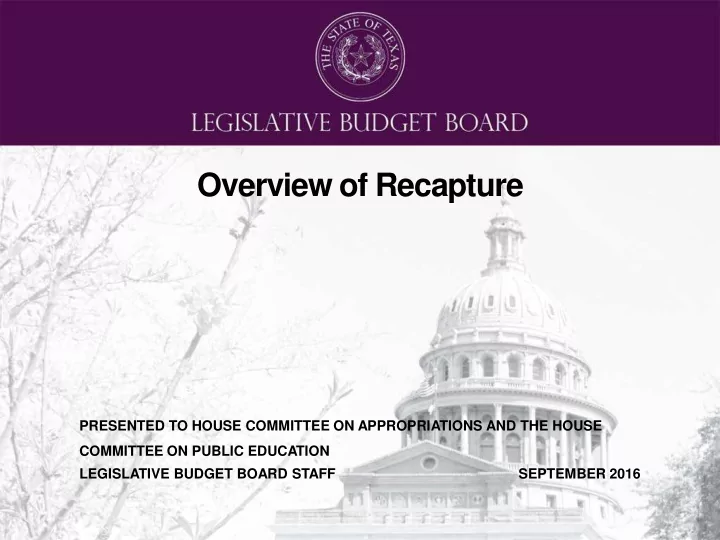

Overview of Recapture PRESENTED TO HOUSE COMMITTEE ON APPROPRIATIONS AND THE HOUSE COMMITTEE ON PUBLIC EDUCATION LEGISLATIVE BUDGET BOARD STAFF SEPTEMBER 2016
Public Education and House Appropriations Committee Joint Charge Study the use of local property taxes to fund public education and its effects on educational quality and on Texas taxpayers. Specifically, recommend ways to reverse the increasing reliance on recapture payments to fund public education statewide. SEPTEMBER 28, 2016 LEGISLATIVE BUDGET BOARD ID: 3535 2
Wealth Equalization Background ● The Texas Constitution requires the Legislature to support and maintain an efficient system of public free schools (Texas Constitution, Article VII, Section 1). ● A recurrent theme in Texas school finance litigation has been that revenue disparities between property-wealthy districts and property-poor districts fail the constitutional efficiency requirement. The Texas Supreme Court has interpreted the efficiency provision to require substantially equal access to similar revenue per pupil at similar levels of tax effort for all students, regardless of the property wealth of the district. ● In 1993, the Legislature created the current wealth equalization system. SEPTEMBER 2016 LEGISLATIVE BUDGET BOARD ID: 3535 3
Wealth Equalization Options A district’s wealth per weighted student is a calculation of the district’s taxable property value divided by its weighted students (WADA). Chapter 41 of the Education Code provides school districts with wealth exceeding statutorily determined levels with five options to reduce their wealth per weighted student to the statutory level: ● Option 1: Consolidate with another school district; ● Option 2: Detach property for annexation by another school district; ● Option 3: Purchase attendance credits from the state; ● Option 4: Contract with a partner district to educate nonresident students; or ● Option 5: Consolidate tax bases with another school district. In practice, most districts choose Option 3, purchase of attendance credits from the state through the process of recapture. The amount of recapture revenue a district provides to the state is calculated to bring the district’s wealth per weighted student down to the Equalized Wealth Level (EWL). Revenue recaptured from school districts is used as a Method of Finance for the Foundation School Program and can only be used for that purpose. SEPTEMBER 2016 LEGISLATIVE BUDGET BOARD ID: 3535 4
Tier 1 Recapture Tier 1 is subject to recapture. The Tier 1 Equalized Wealth Level is statutorily tied to the Basic Allotment. In the 2016-17 biennium, the Tier 1 Equalized Wealth Level is $514,000 per weighted student and the Basic Allotment is $5,140. Because the Tier 1 Equalized Wealth Level is statutorily tied to Basic Allotment, any increase in the Basic Allotment has the effect of reducing recapture revenue. Fiscal Year 2014 Fiscal Year 2015 Fiscal Year 2016 Fiscal Year 2017 Tier 1 Recapture Total (in millions) $1,163.3 $1,430.2 $1,503.4 $1,903.1 Number of Districts Subject to Recapture at Tier 1 EWL 150 158 169 164 NOTE: Number of districts subject to Recapture at Tier 1 EWL includes districts that pay recapture for both Tier 1 and Tier 2. SEPTEMBER 2016 LEGISLATIVE BUDGET BOARD ID: 3535 5
Tier 2 Recapture The first six pennies levied above the Tier 1 Level, referred to as Golden Pennies, are not subject to recapture. The remaining Tier 2 tax effort, referred to as copper pennies, are subject to recapture. The Tier II Equalized Wealth Level for copper pennies is statutorily set at $319,500 per weighted student. Fiscal Year 2014 Fiscal Year 2015 Fiscal Year 2016 Fiscal Year 2017 Copper Penny Recapture Total (in millions) $49.5 $62.4 $81.3 $92.1 Number of Districts Subject to Recapture at Copper Penny EWL 127 139 139 141 NOTES: (1) All districts subject to recapture at the Tier 1 EWL are subject to recapture at the copper penny EWL if they choose to levy copper pennies, although not all do. The amounts noted above include all districts that levy copper pennies and are subject to recapture at the copper penny EWL. (2) Number of districts subject to recapture at copper penny EWL noted above include districts that only pay recapture on copper pennies, as well as those that pay recapture on both Tier 1 and copper pennies. SEPTEMBER 2016 LEGISLATIVE BUDGET BOARD ID: 3535 6
Recapture Analysis • The number of districts subject to recapture at the Tier 1 Equalized Wealth Level has stayed relatively stable over the last 10 years; while the number of districts subject to recapture at the Tier 2 level has grown. • Recapture has increased substantially in the 2016-17 biennium, but as a percentage of the school finance system as a whole, recapture revenue has remained in the 3 to 5 percent range over the last 12 years. • Which districts are paying what portion of recapture has changed over time, particularly with growth in payments from certain large urban districts with high percentages of economically disadvantaged and bilingual populations, like Austin ISD and Houston ISD. SEPTEMBER 28, 2016 LEGISLATIVE BUDGET BOARD ID: 3535 7
Recapture Statistics Fiscal Year 2014 Fiscal Year 2015 Fiscal Year 2016 Fiscal Year 2017 Recapture Total (in millions) $1,212.8 $1,492.6 $1,584.7 $2,022.2 Percentage of Total FSP M&O 3.2% 3.8% 3.9% 4.9% Revenue Number of Districts Subject to 226 241 242 249 Recapture 5 Districts Paying the Most 1. Austin ISD 1. Austin ISD 1. Austin ISD 1. Austin ISD Recapture 2. Highland Park 2. Highland Park 2. Highland Park 2. Houston ISD ISD (Dallas) ISD (Dallas) ISD (Dallas) 3. Plano ISD 3. Eanes ISD 3. Eanes ISD 3. Eanes ISD 4. Highland Park 4. Plano ISD 4. Cotulla ISD 4. Plano ISD ISD (Dallas) 5. Andrews ISD 5. Karnes City ISD 5. Cotulla ISD 5. Eanes ISD NOTE: Data for fiscal years 2016 and 2017 are projected. SEPTEMBER 2016 LEGISLATIVE BUDGET BOARD ID: 3535 8
Contact the LBB Legislative Budget Board www.lbb.state.tx.us 512.463.1200 SEPTEMBER 2016 LEGISLATIVE BUDGET BOARD ID: 3535 9
Recommend
More recommend